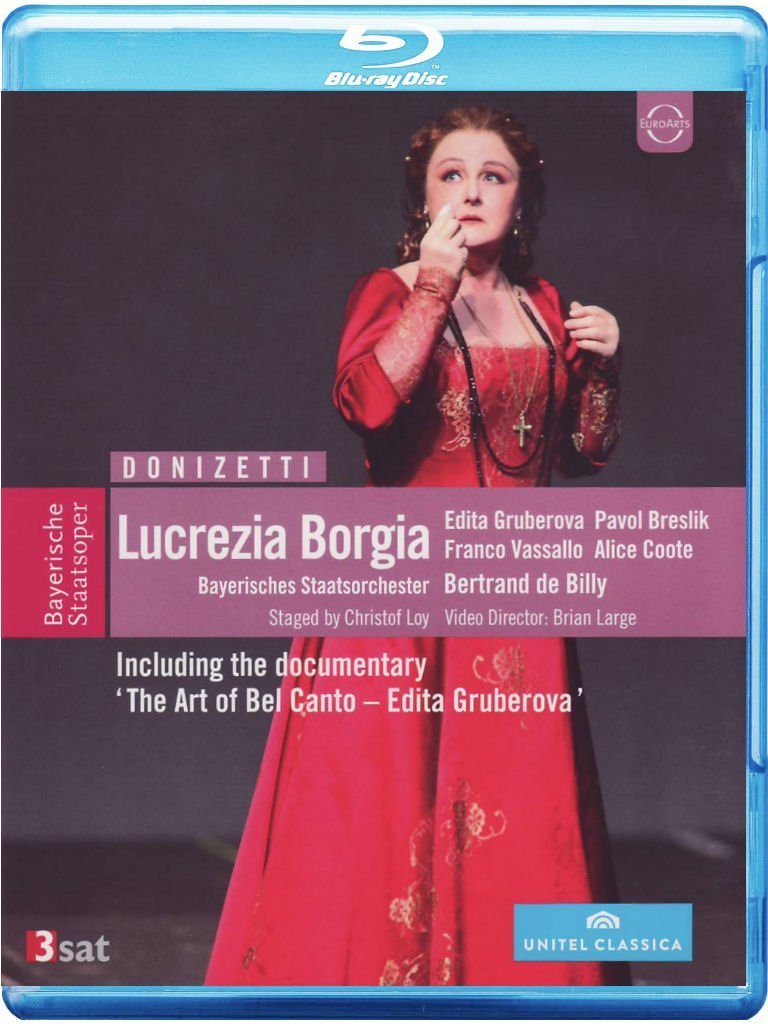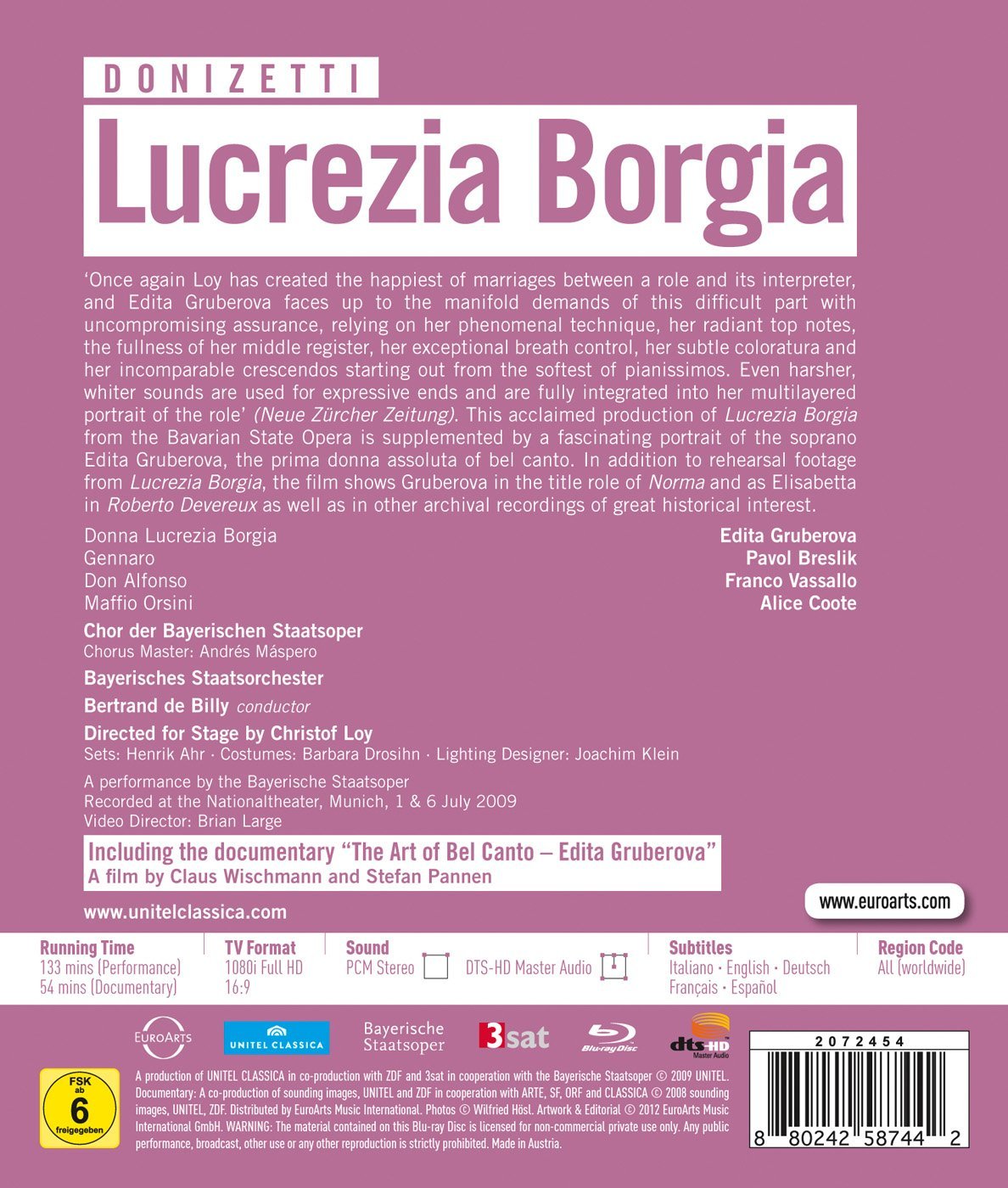

Donizetti Lucrezia Borgia opera to libretto by Felice Romani. Directed 2009 by Chistof Loy at the Bayrische Staatsoper. Stars Edita Gruberova (Donna Lucrezia Borgia), Franco Vassallo (Don Alfonzo), Pavol Breslik (Gennaro), Alice Coote (Maffio Orsini), Bruno Ribeiro (Jeppo Liverotto) , Christian Rieger (Don Apostolo Gazella), Christopher Magiera (Ascanio Petrucci), Erik Årman (Oloferno Vitellozzo), Steven Humes (Gubetta), Emanuele D'Aguanno (Rustighello), Christian van Horn (Astolfo), and Elisabeth Haag (Principessa Negroni). Bertrand de Billy conducts the Bayerisches Staatsorchester and the Chor der Bayerischen Staatsoper (Chorus Master Andrés Máspero). Stage Music Director: Gregor Raquet. Sets by Henrik Ahr; costumes by Barbara Drosihn; lighting by Joachim Klein. Directed for TV by Brian Large; director of photography was Gerald Schäfer; audio engineer was Stefan Kröhn; sound engineer was Jakob Palfrader; produced by Magdalena Herbst. Disc also includes a 54 minutes documentary "The Art of Bel Canto—Edita Gruberova" by Claus Wischmann and Stefan Pannen. Sung in Italian. Released 2012, disc has 5.1 dts-HD Master Audio sound. Grade: A
Wonk John Aitken kindly contributed this (slightly edited) comment as a mini-review of our Chistof Loy Lucrezia Borgia:
"This production was very well received in Munich when I saw it. At this stage in her career Edita Gruberova is ideally cast as the title character and produces some wonderful bel canto singing. Always a favourite in German houses, she scored a great personal success in this production by Christof Loy. The simplicity of Loy's production works very well indeed. Those people who prefer a more traditional approach can choose Renee Fleming in San Francisco Opera's production though even it pales when set against the outrageously over-the-top production given to Joan Sutherland at the Royal Opera House in London (DVD). I much prefer Munich's simple and monochromatic staging which allows the drama to unfold clearly. If Gruberova was the only reason to purchase this version it would be recommended. However, add the splendid Pavol Breslik as Gennaro, Alice Coote as Maffio, and Franco Vassallo as Don Alfonso and you have a truly exceptional cast. Of course this is par for the course in Munich where standards must consistently be amongst the best in the world both in terms of singing and staging. As it is, this is a marvellous performance which I wholeheartedly recommend."
John speaks here of his experience seeing the actual performance at the Munich opera house. I'll add some comments and screenshots based on my review of the disc published by EuroArts. In the first picture, we see Loy's simple staging. Loy has 8 operas out now in HDVD, and we have done full reviews of 3 of them. He often uses a plain stage with few props other than chairs, and he often dresses the chorus and many of the stars in modern black and white as you see here (with the pants rolled up to indicate that the men are students or cadets even though in the libretto they are soldiers):
Loy even did a Lulu in black and white as seen in the next shot:
And here's a picture of Loy's basic box in Les vêpres siciliennes:
But not all of Loy's staging is so drab. Here's a more colorful shot of a scene from Die Entführung aus dem Serail:
Most of the color in this Lucrezia Borgia is provided by the costumes for the leading lady, Edita Gruberova. Here she is portrayed in a surprising sympathetic light as a woman with a conscience:
On the left is Pavol Breslik as Gennaro. On the right is Alice Coote in trousers as Gennaro's best friend and comrade-in-arms, Orsini:
Loy does a good job in his personal directing of the singers. He's quick to inject odd-ball humor into serious scenes. Here's a good example of this with the clown makeup on Steven Humes playing Gubetta, Lucrezia's secret agent and spy:
Lucrezia is fascinated with Gennaro. She suspects that he might be a son that she lost as a baby. In the scene below, she has confirmed her suspicion, but is still not ready to reveal the truth to anyone:
Gennaro is strangely attracted to lady with no name, but he soon learns that she is the hated Lucrezia Borgia:
Borgia is married to her 4th husband, Don Alfonso (Franco Vassallo seated below). The Don and his secret agent/spy Rustighello (Emanuele D'Aguanno) erroneously believe that Lucrezia has taken Gennaro as a young lover. Alfonso seeks evidence he can use to have Gennaro killed:
More humor from Loy depicting the obsequious Rustighello shining his master's shoes:
Gennaro wants to prove to his friends that he has no love for "the Borgia." He defaces a royal coat of arms by removing the "B," which then leaves the obscene word "orgia" to describe Lucrezia:
Lucrezia doesn't know who defaced the coat-at-arts. She asks Don Alfonso to punish the vandal with death. When Don Alfonzo discovers that Gennaro is the guilty one, he's overjoyed to see a way to get rid of his rival:
Soon Lucrezia learns that her son is the culprit who has been caught by the Don. Now there is a delicious cat-and-mouse game between the two tyrants as the Don plots to kill his stepson after letting him think that he has been pardoned:
Lucrezia chooses poison for her son because she has a secret antidote. Gennaro escapes one death, but will soon be threatened by another:
Princess Negroni (what a name!) invites all the young men to a party. Elizabeth Haag got the easiest role and credit in the history of opera. She sings no note, says no word, makes no expression, and has no task except to get on and off the stage without falling down. This zombie role is appropriate, I surmise, because the party invitation is treacherous. And I think Loy also insists that this opera has only one female protagonist, i.e., Lucrezia:
I don't want to give away everything, so I'll close the screenshots saying there's considerable more drama at and after Negroni's party, including this nice mother-and-son image:
Everything about the music in this production and recording is good to fabulous. The personal directing by Loy and the acting by all concerned is fine. And, per John Aiken, the cheap set, props, and costumes don't necessarily detract from the show.
I'm not sure, however, if John would be as enthusiastic about the video as he was about seeing this live. John is a fan of live opera, and he's keen on whole-stage video shots that mimic being there. Brian Large, the most experienced videographer in the world, shot this. Large provides full stage views, especially when there are lots of folks on the stage. Still, no video is going to be as engaging as seeing the live show. And if the set is plain, the good videographer probably feels compelled to move in for dramatic near shots and close-ups, especially when the singers are also great actors. And I guess my choice of screenshots reveals a desire in this situation to show off the close-ups—something you can't see so well in the opera house unless you have a $300 ticket.
Finally, bonus documentary ,"The Art of Bel Canto---Edita Gruberova", does a good job of glorifying the career of Edita Gruberova, who was maybe the leading coloratura soprano in the world in 2009.
Now to a grade. Based on Aitkin's wholehearted approval and the nice Brian Large video, I'll give this an "A."'
Here is a clip from EuroArts:
OR


















